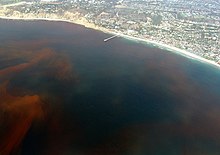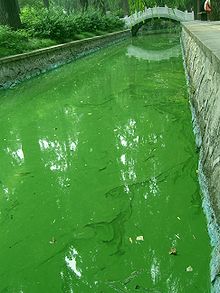Algal bloom
When algal blooms (sometimes water bloom ) is defined as a sudden, mass propagation of algae or cyanobacteria (blue-green algae) in water . The algae bloom turns the water surface green, in special cases also blue or red ( red tide or red tide ), the water becomes cloudy and “cloudy”. The cause is usually an over-fertilization of the water with phosphate . The English term red tide , Germanized to red tide , is used for algal blooms in general, regardless of the specific discoloration, i.e. not only when it is red.
description

In a narrower sense, one speaks of algal blooms in the mass development of a single species of algae or cyanobacteria, which are characterized by their ability to collect directly on or below the surface of the water. As with various cyanobacteria species ( Microcystis sp., Oscillatoria sp., Anabaena sp. Etc.), this can be done by buoyancy, or, as with several flagellated algae species ( Karenia brevis , Euglena sp., Oocystis sp. Etc.) by active searching the surface. The eye animal Euglena sanguinea can color the surface fiery red, an Oscillatoria species ( O. rubescens ) blood to raspberry red, and a Microcystis species sky blue. The term "blossom" is then obvious.
In the case of algal blooms, the light is already strongly weakened on the surface, so that there is only enough light for photosynthesis down to a small depth . Below this, oxygen is consumed both by the sinking algae and by the increasing number of consumers . For more information, see Ecosystem Lake and Eutrophication .
In addition, the algae and cyanobacteria often produce toxic substances that can be dangerous for living creatures in the lake and also bathers (for example algae toxins and microcystins ). With the mass reproduction of toxic algae one speaks of oneharmful algal blooms (Engl. harmful algal bloom , shortly HAB ) or toxic algal blooms .
Large-scale algal blooms in the oceans are due to nutrient-rich ocean currents and upwelling effects. In 2009 (since December 2008) in the Persian Gulf and Gulf of Oman there was a massive algal bloom caused by the dinoflagellate Cochlodinium polykrikoides , which led to fish deaths in natural populations and fish farms, damage to the coral reefs and problems in obtaining drinking water from seawater desalination plants throughout the region . A total of around 1200 kilometers of coastline were affected. Previous algal blooms in the Gulf of Oman by Noctiluca scintillans had already led to fish deaths there 25 times. Both the frequency and strength of algal blooms in the region appear to be increasing. The main reason seems to be that the natural upwelling of nutrient-rich deep water caused by eddy currents has been intensified by local marine pollution and the introduction of alien dinoflagellate species.
Due to the rise in water temperatures as a result of global warming , a further increase in algal blooms in lakes and seas, especially in the temperate latitudes near the coast, is to be expected. For example, the marine heat wave “The Blob” that occurred off the west coast of the USA in 2014–2016 caused a bloom of poisonous diatoms that made fishing impossible for several months. In the Arctic, the receding sea ice leads to more frequent algal blooms, and higher levels of algae toxins have been found in mussels and marine mammals . Since cyanobacteria in turn produce the strong greenhouse gas methane , there is a possibility that there will be a self-reinforcing effect in which global warming initially triggers more algal blooms, which in turn amplify climate change through increased methane production.
Web links
Individual evidence
- ↑ Entry on algal bloom. In: Römpp Online . Georg Thieme Verlag, accessed on June 4, 2020.
- ↑ Tomotoshi Okaichi: Red Tide Phenomena. In: Tomotoshi Okaichi (Ed.): Red Tides . Terra Scientific Publisher, Tokyo and Kluwer Academic Publishers, Dordrecht etc. 2003. ISBN 1-4020-1512-7 , p. 7 (English).
- ^ Harmful Algal Blooms, A Compendium Desk Reference - Description. John Wiley & Sons, accessed October 18, 2019 .
- ↑ Mindy L. Richlen, Steve L. Morton, Ebrahim A. Jamali, Anbiah Rajan, Donald M. Anderson (2010): The catastrophic 2008–2009 red tide in the Arabian gulf region, with observations on the identification and phylogeny of the fish -killing dinoflagellate Cochlodinium polykrikoides. Harmful Algae 9: 163-172. doi: 10.1016 / j.hal.2009.08.013 (English).
- ↑ O'Reiley et al .: Rapid and highly variable warming of lake surface waters around the globe . In: Geophysical Research Letters . 2015, doi : 10.1002 / 2015GL066235 (English).
- ^ Karen M. Brandenburg, Mandy Velthuis, Dedmer B. Van de Waal: Meta ‐ analysis reveals enhanced growth of marine harmful algae from temperate regions with warming and elevated CO 2 levels . In: Global Change Biology . May 2019, doi : 10.1111 / gcb.14678 (English).
- ↑ Vera L. Trainer u. A .: Pelagic harmful algal blooms and climate change: Lessons from nature's experiments with extreme . In: Harmful Algae . May 2019, doi : 10.1016 / j.hal.2019.03.009 (English).
- ↑ Volker Mrasek: Marine heat wave "The Blob" - death sentence for sea creatures. Deutschlandfunk, June 8, 2018, accessed March 7, 2019 .
- ↑ Arctic Monitoring and Assessment Program (Ed.): Arctic Climate Change Update 2019 - An Update to Key Findings of Snow, Water, Ice and Permafrost in the Arctic (SWIPA) 2017 . May 2019, p. 6 (English, amap.no [PDF; 2.2 MB ]).
- ↑ M. Bižić: Aquatic and terrestrial cyanobacteria produce methane . In: Science Advances . tape 6 , 2020, doi : 10.1126 / sciadv.aax5343 (English).


